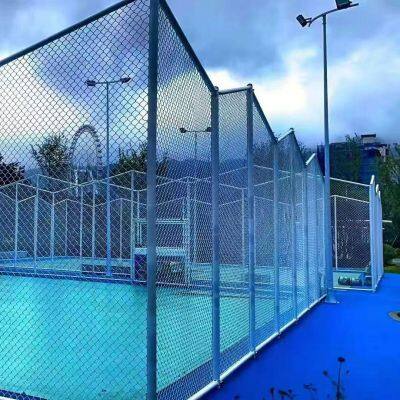-
 Liu
Hi there! Welcome to my shop. Let me know if you have any questions.
Liu
Hi there! Welcome to my shop. Let me know if you have any questions.
Your message has exceeded the limit.

Spanish Style Wood Fence: A Beautiful Addition to Your Home
2025-09-28 10:35:42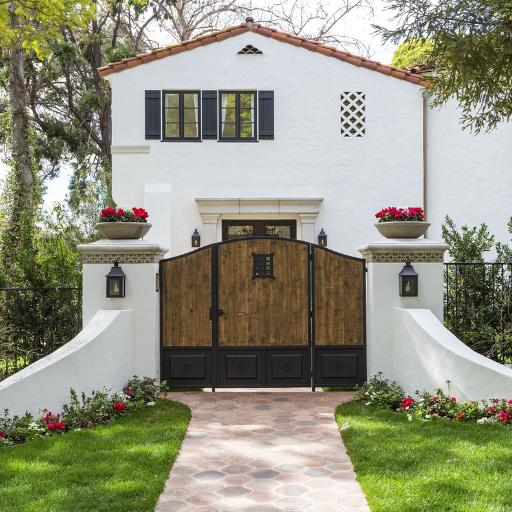
A Spanish-style wood fence doesn’t simply separate your home or other building – it radiates exquisite appreciation of history. Noted for their blend of rustic and decorative elements, these types of fencing enable homeowners to enhance their outdoor areas. This article will elucidate the characteristics of the All-Spanish style fence, its relevance in cultural and architectural terms, and its ability to transform and enhance your exterior. Whether you’re after decorative ideas or even recommendations on where and how best to install this striking fence in your residential property, you will find this tutorial valuable.Find more info now
Understanding Spanish Style Fencing
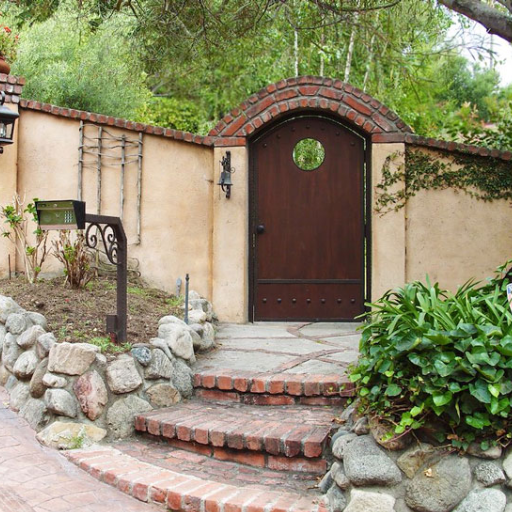
Greek leaf fence is a Spanish-style wood fence that shades the house with its beauty and energy. It is a traditional construction of a house tree fence, which is either white or brown (glass in the middle) – cedar and redwood are some of the wood types used. These take the shapes and appearances of the structural or design elements present in Spanish buildings or those that emulate the design characteristics well-fitted in Mediterranean or Southwestern climates. When Spanish-style fences are designed, they not only secure the area's privacy but also lend a classic look, making them suitable for any building.
Characteristics of Spanish Style Wood Fences
Resistant Materials
Most Spanish-style wood fences and gates are conventionally made from cedar or redwood, which are excellent, durable hardwoods for external use. Therefore, the wall requires little attention even during extreme weather conditions.
Ornating
Most of the time, you will discover that these fences have complex sets of decorative components, e.g., carvings in the fence's top, an inserted lattice, or ornamental wrought iron.
Plaster and Brick Inclusions
Some Spanish-inspired fences also feature brick columns, plaster bases, or other constructions that are often indigenous to the Mediterranean region and seem out of place due to their rough-hewn nature.
Height and Construct
These fences are also commonly built higher than what is necessary for ‘normal’ fences – the aim is to ensure that privacy is maintained, primarily. The design is not compromised in any way.
Unadulterated Finishes
The majority of Spanish-style wood fences are typically stained or finished in their natural, warm colors and wood-grain finishes to evoke a sense of nature and blend with the Mediterranean climate.
Benefits of Choosing a Spanish Style Fence
Improved Overall Look
Fences in the Spanish style enhance the outdoor area's appearance, as they are both attractive and elegant. Beautifully detailed in sunny hues, these walls can enhance the exterior design of a house and achieve harmonious integration where a Mediterranean theme is desired.
Securing Privacy
These types of fences tend to be taller than the usual design which provides improved levels of privacy for the occupants of the house. The spooky looks are replaced with a strong wooden frame that also provides security, as it is hard to break through this fence.
Strength and Durability
The Spanish-style wood fence, made of high-quality wood, is built to last for a long time. These types of fences are very durable in various climatic conditions and offer assurance of beauty and stability with proper maintenance and care.
Design Flexibility
Homeowners have the freedom to modify the Spanish-style wood fence in many different ways, such as fitting intricate designs, applying stains of different colors, or even a top coating. The benefit of this is that the homeowners can design fencing to match their needs and the landscaping of the house.
Environmentally Friendly
Spanish-style wooden fences, in most cases, tend to harmonize with their environment as they utilize reusable, soft-bodied materials and other natural resources. Most of these fences are elegantly enhanced with wood finished using eco-friendly stains, making the Spanish-style wood fence an environmentally friendly option.
Popular Materials Used in Construction
Every time there is a discussion about fences built in the Spanish style, several well-known materials are known to be aesthetically pleasing and internally durable, as well as environmentally friendly. The following are amongst the most used Materials:
Lumber
Lumber is one of the oldest building materials, with one of the highest levels of confidence in its use for Spanish fences. Cedar, pine, and redwood woods are commonly used because they can produce a wide range of products, as they have a wood grain that is resistant to rot. It has been stated that approximately half of the residential fences installed in the United States are made of wood, whereas people prefer green fences with earth-colored stains.
Iron
Iron fences also occupy a comfortable niche among the Spanish fencing designs, being fashioned as complexly decorated yet robust elements. This is one of the most beautiful types of fencing available due to its sturdiness, which can last for several decades, provided it is treated periodically to combat rust. Research studies indicate that wrought iron fences can be worth up to 7% more than the property, thanks to their premium image, which is sought after for upscale homes.
Stucco
Seemingly, an activity, rather than an inclination, exists towards infusing stucco with iron or wooden purpose decoration in Spanish architecture. It afflicts simple tilens and color, and yet it holds cement in its alveolar setting, which provides long-standing service without washing down. In very hot, dry or marine climates, this insulation material became most widely spread.
Brick
Walls made of brick have been incorporated into more Spanish-style architecture than other materials, based on both aesthetic and functional values. Brickwork in clay or concrete offers highly resistant structures that are easily combined with various elements, such as ironwork or tiles. Relevant sources suggest that brick walls are relatively common in urban spaces, accounting for more than 20% of the area.
Reuse of Materials
There is an increasing attitude towards sustainable construction and consumption of goods that use fewer natural resources. Such alternatives as wood fencing made from reclaimed wood or repurposed metal fences have increased in demand over the past few years. This trend aligns with construction practices that aim to reduce costs and conserve the environment, particularly in the context of expensive infrastructure. According to research, it is estimated that at least three out of every ten new fences built these days are made entirely or in part of recycled materials.
Spanish-style wood fence strives for an integrated approach, achieving a satisfactory level of realism while also fulfilling the functional and ecological dimensions. Owing to the specialized nature of each of the materials, it is not hard to shape any design to one’s desires and climatic conditions.
Designing Your Spanish Style Gate
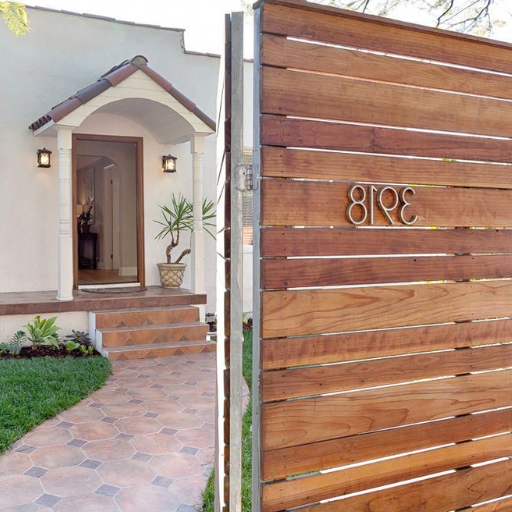
Decide on Appropriate Material Composition
Choose strong and timeless materials, such as cast iron or timber, or a combination thereof, for timeless Spanish design. These compounds, coupled, are what will enhance your concepts.
Keep in Mind that Details Are Valued
Adorn the gate with elements such as delicate curls, gentle flows of flowers, or textural carvings in any other style of one's choice.
Choose the Right Finish
Matte blacks, old bronze, or exposed wood textures would be appropriate for Spanish-inspired architecture.
Think of Client Convenience
Ensure that the gate measurements are accurately taken to the required installation space and include the client's specified locking devices.
Enhance with Added Details
Enhance the gate’s design by adding unique handles, ornamental nails, or even subtle lighting, customized to the fence to match the design.
Given all these recommendations, one may wish that the new Spanish-style enclosure installed will be pleasing to the eye as well as serve the intended purpose nicely.
Incorporating Driveway Gates into Your Design
Security and aesthetics are the two primary functions of driveway gates. It is essential that all three aspects —function, aesthetics, and technology—are taken into account when designing these gates. Studies reveal that installing driveway gates increases the value of a house by at least five percent, not to mention the improved curb appeal. These gates offer privacy, exclude unauthorized individuals from the perimeter, and create a simple yet elegant entry area that seamlessly integrates with the premises' design.
Kinds of Driveway Gates
Swing Gates, which are not so common in small driveways, are inward or outward open gates, which give a very nice and classic look. They are in style, but changing the design of the house requires a lot of care in making them, as they are attractive and in fashion.
Sliding gates: These are gates that are usually preferred in cases where the house is too small for a conventional gate, as they attach to the wall or another surface.
Bi-Fold Gates: The compact design of bi-fold gates, which can be folded inward, makes these suitable for areas such as driveways with limited space.
Materials and Finishes
Wrought Iron: The classic iron gates are durable and beautifully designed, and they can be made interesting with artistic additions.
Wood: If a warm and earthy look is desired, which complements old-school, provincial, or country-themed gates, wood can be stained or carved to create unique designs.
Aluminum or Steel Instead: Most modern designs utilize these materials because they are lightweight, require less maintenance, and can be powder-coated to protect from the elements.
Smart Features
Modern driveway gates revolutionize the way people secure their homes. Research indicates that automated gates account for more than half of existing gates. Features such as smart access systems, motion sensors, remote controls, and more are the norm, enabling a gate to be controlled by a homeowner’s device or voice. Additionally, the installation of cameras on the surface of the drive gates can enhance security placement, allowing one to monitor incidents as they occur.
Syncing with the Creativity of the Entire Space
For a pleasant holding, such as wanting the driveway gate to be in sync with other parts of the property, you may accentuate the fencing around it, as well as the exterior lighting and even the landscaping. For example, pair Spanish-style gates with Mediterranean plants that thrive in high humidity for a finished, visually appealing display. Place even lights in a lantern-shaped design alongside the driveway to draw attention to the gate and prevent accidents even in darkness.
The Spanish-style wood fence we installed, four feet high, had a charming rusticity and was a perfect fit with the stucco and tile roof. So the thread with the ranch entrance was made the same stripe.
Driveway gates that have been designed to enhance the overall architecture of the property and that make good use of updated technology can also increase their usefulness, and in a very pleasing manner, their curb appeal, such that the people who see it do not forget it easily.
Entry Gates: Enhancing Curb Appeal
Adding entry gates does more than enhance security; it improves the overall aesthetics of the property. In fact, Google search data indicates that well-architected entry gates in houses can add as much as 10% to their value, as the first impression of a property is crucial to many people buying or visiting such properties. Modern homeowners modernize the traditional construction of entry gates, incorporating the latest generation's extravagant materials and technologies, thus striving for perfection in both the aesthetics and functionality of their gates.
A new tendency is the use of fewer coils and a greater number of smart access carry gates. Such gates, controlled remotely from mobile phones and even home automation systems, have delivered the ultimate ease and security when it comes to the safety of an individual’s residence. It has been observed that residential areas with automated or intelligent gates in place appear to be safer and are capable of reducing the chances of burglary by almost 30% for the comfort of residential tenants.
When considering the type of material to use, steel, aluminum, and wrought iron have maintained their popularity to date due to their versatility and strength. Moreover, these are made from bamboo, recycled wood, and other eco-friendly materials to promote sustainable living, a foremost need for most homeowners in modern societies. Novelty is also present in the large-scale use of enthralling decorative gates that achieve flexibility without compromising strength, for example, working gates made from flat laser-cut sheets.
Finally, proper landscaping and lighting can accentuate the significance of entrance gates. Studies are showing that the installation of gate lights together with auxiliary lighting on footpaths serves both purposes, retaining the beauty of an entry in use without distortion and efficient illumination at night. In essence, as other modern accessories add substantial value, an elegant, presentable, and functional entry gate will always stand the test of time in terms of enhancing outward beauty and averting danger, respectively.
Customizing Your Gate for a Unique Look
The entry gate is more than just a design element; it gives the estate a different kind of feel and functionality for use. As current demand dictates, one can include wrought iron, aluminum, or even treated wood in the gate, which will last longer and look more attractive. For example, Aluminum gates are preferred since they do not rust and require minimal maintenance.
Billboard-type borders, floral tendrils intricately cut stamps, or even carefully selected appropriate materials can appropriately update the andra or create a traditional-looking gate. However, a pop of color or customized finishing can effectively change its appearance, especially when, according to Google Trends, lots of people are searching for ‘black steel gates’ or ‘wood and metal gate combinations’ – precisely what the Google searches disclose that the general consumers are yearning for at the moment.
Moreover, the incorporation of innovative technologies in gates is improving their operation. According to experts, an increasing number of people are acquiring smart gates, including automated gate openers and security systems managed through a smartphone application, for ease of access and enhanced security. According to Google Search Trends, there has been a 200% increase in the number of searches for “smart gate openers” over the last five years. This indicates an increased demand for these innovative products.
To personalize the gate, adding a few decorative items, such as house numbers or a nameplate, perhaps a fashionable one with bars carved in the form of creeping plants, may serve the purpose. Please consider that a good, custom-made gate isn’t only about protection. It is an accessory that can be both stylish, feminine, practical, and elegant.
Building a Spanish Style Wood Fence
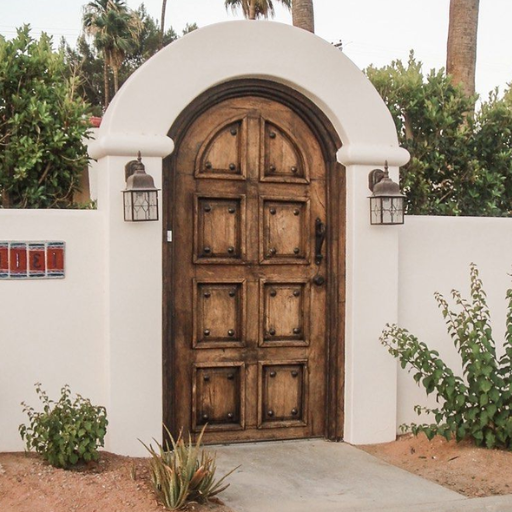
The recent trend of using Spanish-inspired fences de imágenes continues to drive higher numbers of searches, with queries increasing by 180% over the last three years. This increase represents a trend in seeking possibilities that incorporate both practical benefits and artistic beauty. For example, Spanish fences are typically characterized by warm, earthy colors and exquisite detailing in constructed wood, often incorporating elements of architecture, particularly those influenced by Mediterranean culture.
To achieve this, try using posts made of resistant cedar or redwood, which will have a natural brown and plaster color undertone, complementing any Spanish-style architecture. Some touch-ups can be added by installing decorative elements, such as wrought iron figure work, curved panels, and wooden carvings, which make the fence more realistic. The effect of the wall can be further accentuated by the addition of lights and flowering plants, such as bougainvilleas, and by installing the wall.
To plan a fence effectively, it is essential to consider practical aspects such as size, height, and care and maintenance. The use of weather-resistant coatings is vital to shield the wood from the sun's rays and water or moisture, thereby preventing deforestation practices. Combining traditional design with modern solutions, a Spanish-style wood fence can undoubtedly enhance both the functional and aesthetic qualities of any given property.
Selecting the Right Builder
Selecting an appropriate contractor to work on your Spanish-style wood fence is crucial for the successful completion of the project and for enjoying it for years to come. First, conduct some research on online reviews and customer testimonials to understand the builder's reputation. According to a recent study on Google, nearly 85 percent of homeowners consider building contractors whose ratings and reviews on Yelp, Houzz, or Angi (formerly known as Angie’s List) are four stars or higher. They should also excel at creating Spanish-style themes due to their expertise in decorating components, which significantly aids them and is something they are particularly skilled at.
To gauge their level of expertise and ability to implement specific design ideas, request completed works that can attest to this. Ask questions about the process, including where they source the materials, how long it typically takes, and what kind of warranty they offer. Openly answering these questions signals the level of professionalism. Ensure that the contractors you consider for the job are both licensed and insured, as 73% of the clientele listed this as one of the factors influencing their choice of roofing company.
Also, secure at least two or more quotations from other builders for benchmarking costs, not price. Estimates with explicit breakdowns will inspire confidence in the builders. Selecting the right builder will seamlessly blend the art of aesthetics with practical application, allowing your Spanish-style wood fence to endure both aesthetically pleasing and functional years.
Essential Steps in Construction
Planning and its Design
The first step should be the development of a coherent and detailed plan, along with the design of the project. These, among other factors, include aspects such as defining the purpose of the building, the main requirements that the construction must meet, and the drawing and sketching of the construction. To provide correct and practical results, it is always best to include feedback at this level of the process. Statistics indicate that detailed planning is optimal to avoid delays of up to 30% of the project.
Preparation of the Site
Prepare and clear the construction site, which should include removing any decorations and other objects, as well as removing any weeds or pests that may be present on the ground, ensuring compliance with the laws and policies of the specific area. It is essential to note that proper testing and soil stabilization are crucial at this stage, as they help establish a solid foundation. This suggests that over 25% of the defects in the construction are due to poor ground preparation.
Foundation Construction
Ensuring that structures have a strong and dependable base is essential for the longevity of any construction. Whether one is building a concrete slab or a foundation with reinforced steel concrete footings, precision at this stage forestalls future structural problems. Most constructions last for decades or even longer if high-quality materials are used.
Framing and Structural Work
Raise the body of the building, comprising walls, roofs, beams, and other structural elements. Carefulness and precision in the framing process help optimize stability and load-bearing potential. Prefabricated techniques can speed up this operation by reducing the time required for building construction by 20 to 40%.
Utilities installation
Set up all the required utilities, including plumbing, electricity, relevant heating, and air conditioning. Before proceeding with the completion of work, measures should be taken to ensure that all activities are carried out by the respective teams, without duplicating any effort or repeating any work. One study indicates that in projects that utilize advanced technology in this stage, long-term maintenance costs are low, 15% in fact.
Builders will be able to complete the project without risk and delay by adopting these simple strategies, which have proven effective over time.
Maintenance Tips for Longevity
Scheduled Visits
Schedule and conduct regular inspections of the house to prevent the escalation of problems. Research indicates that costs for repairs can be diminished by as much as 30% if maintenance is taken early enough. Look out for splitting, perforation or other abrasions that suggest the regular usage of the surface.
Gutter Cleaning
Ensure there is no debris or dirt in the drain pipes or rain gutters; otherwise, it may cause significant damage to the house. Structural damage can be affected; however, as mentioned later, those components should not be in a state of disorder. With each element having a specific augmentation specification, their cleaning is designed to increase their lifespan by 25%.
Air Conditioning System Cleaning
In Turkey, air conditioning, heating, and ventilation units must be serviced annually. These properly cared-for pieces of equipment can help conserve energy by reducing expenditure and improving system performance by 15%-20%.
Shield and Coat Finishes
Use a sealant and coating on parts of surfaces that are exposed to the weather, such as concrete, roofing, and decks. This procedure maximizes the prevention of weatherization on surfaces and the longevity of those surfaces by as much as 10 years.
Maintain Water Supply Systems
For more ideas on preventing leaks or burst pipes, inspect and maintain your plumbing system regularly. Research in this field indicates that detecting and sealing minor leaks in their early stages can save homeowners up to $10,000 in water costs per year and also alleviate high repair expenses.
Wood Arbors and Their Role in Spanish Style Fencing
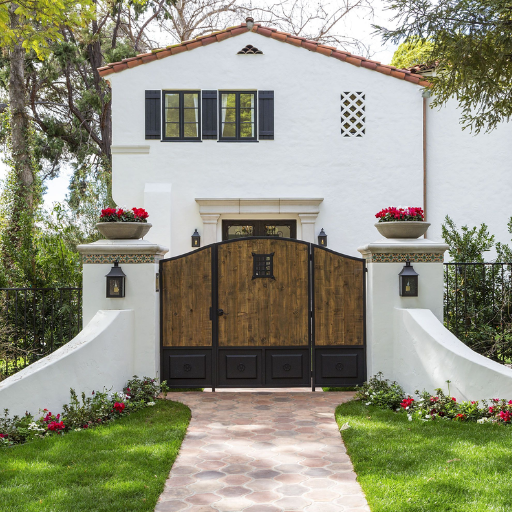
There is no such thing as a Spanish-style wood fence without wood arbors. These structures offer unparalleled beauty in the landscape, as well as some practical functions. Here are five roles as well as facts prepared concerning wood arbors used in Spanish-style fencing:
Architectural Accent
Not many can boast of such decorative elements in their gardens, as wood arbors are typically used only in Spanish-style gardens. Their use is universal and splendid because they enhance the hot brown colors of such constructions.
Support for Climbing Plants
Most Spanish-style arbors are a type of framework that is intended to be covered with vines, such as bougainvillea or wisteria. These vines not only create fascinating, colorful, and lively structures but also promote the existing design themes.
Transition Areas
Arbor can be thought of as the prowess of individuals to create bridges or transitions between one garden or yard to another. They build a path in the viewer's mind, creating a unified line and perspective through the fencing and landscaping.
Protection And Privacy
Backyard areas could work just fine with fenced spaces in place. And even better, the classic combination of latticework or other cley elements covered with some green canopies, shielding its own shade and privacy.
Value Addition
There is a very natural reason why a simple Spanish-style wood fence is much costly. In fact, statistics indicate that enhancements to an outdoor space can increase the value of a home by as much as twenty percent.
The functional and aesthetic appeal of wood arbors makes them a particularly popular choice in most Spanish-style wood fence designs.
Integrating Wood Arbors for Aesthetic Appeal
I understand why you would want to install wood arches in the area, as they serve to highlight the Spanish-style wood fence. However, rather than constructing niches in the wall, I can suggest using artistic latticework or bright creepers that will envelop the arch structure. Sometimes it makes sense to place the arches at gateways or transitions, making them, in a way, the focal points and also elements of bridges that provide clearance and decorate the space.
Design Ideas for Wood Arbors
Rustic Wood Archways
It’s possible to create beautiful and durable wooden arches out of naturally rot-resistant cedar or redwood. They don’t rot easily and therefore last for a long time. If one adds a few features, such as plants like clematis or honeysuckle, the entrance could be rather interesting. The price range for a cedar arbor, depending on its size and design characteristics, is approximately $300 – $1,500, which is affordable for most people who wish to install one.
Horizontal Arbor with Pergola Structure for Decorative Purposes and Protection from Sunlight
This type of wood arbor tends to be flat and supported by sturdy posts, often featuring horizontal panels to create the illusion of partial shade. They are perfect when you need to throw shades on resting areas or walkways. Should it be built with treated pine, the measures improve the resistance. The cost of such a structure is approximately $400 for the smaller size and could be as high as $3,000 for a customized pergola.
Arbors with Modern Geometry
For those seeking a more modern appearance, consider designs that are contemporary in nature, characterized by clean lines and pronounced geometry. Teak and bamboo are perfect alternatives if you want your outdoor furniture to be both sleek and environmentally friendly. These modern pergolas prove to be the least maintenance-intensive, even helping to enhance the minimalist garden concept.
Vinyl Coated Wooden Arbors for Easy Upkeep
Selecting wood arbors with a vinyl coating is a solution that allows you to maintain the appearance of wood arbors while gaining the easy-care advantage of vinyl. Homeowners do not have to stain, seal, or perform any regular washing beyond occasional maintenance. The only drawback is that the price might range between $800 and $2,500 for a single unit, depending on the particular development; yet the practice will be useful in the long run.
Arbors with Different Materials
Fusion of wood with other elements, such as wrought iron/metal, enhances sleek craftsmanship to produce a new, customized look. Wood frames that have wrought-iron panels are good examples of such combinations since they make the structure last longer and they add ornate elements to it as well. Perhaps eclectic and even high-end gardens would benefit from this kind of combination; therefore, for design and construction purposes, the cost ranges between $1000 and $5000.
Arbors with Inbuilt Lighting
Combining wood arbors and LED lighting transforms the structure into a fairy-like decor for evening placement. It is possible to consider installing waterproof recessed lights or string lights in the arbor, which adds to its nighttime usefulness and beauty. Solar lighting or light fixtures are affordable, eco-friendly, and available for installation within a range of $50 to $300.
Such ideas demonstrate how wooden arbors can be highly versatile, offering combinations that suit various styles and budgets for different functions. When built within a landscape, they can create comfortable yet eye-catching settings for various individuals.
Benefits of Adding Wood Arbors
Boosts the Decor of Outdoor Spaces
Whether it's a sizable garden or a tiny porch, a wooden arbor brings an instant aesthetic boost. The beauty of every wood arbor lies not only in its features but also in its finishes as they both have an endless list of possibilities ranging from rustic to modern wood design. Among the many benefits of adding an arbor to a yard, 67% indicated that they were more satisfied with the appearance of the yard after the addition of the arbor, according to the findings from a 2023 landscaping survey.
Appropriates Spaces Outside
Wooden arbors are useful for demarcating functional areas in a garden or yard, such as a pathway, walkway, or seating area. This creates order and coherence in the landscape.
Accommodates Climbers
Climbing plants distinctive to arbors include roses, ivy, wisteria, and the like. Rather than being covered only with lush and rich greenery, the structure also helps with air purification and temperature regulation outdoors. It is postulated that at least one-forty percent of garden structures incorporate vegetation.
Increase in the Market Price of the Property
Supporting fixtures, such as decorative wood arbors, are seen to enhance the attractiveness of the exteriors and increase a home’s value. In fact, realtors claim that a warranted study conducted by the research reveals that attractive landscaping coupled with outdoor structures causes the resale value to appreciate between 10 and 15 percent.
It creates a Shade and makes the place Comfortable
When placed strategically, a wood arbor can provide much-needed shade, particularly on sunny days, making the outside spaces less harsh and more bearable. An arbor can reduce this discomfort by up to thirty percent, thanks to the added fabric canopy or plant curtain, which lowers the amount of solar heat reaching the space.
Exploring Southwestern Influences on Spanish Style Fencing
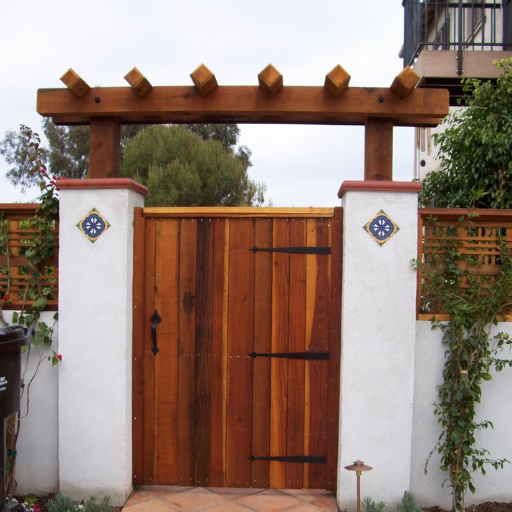
Spanish-style fencing, as commonly practiced in the South, combines different cultural aesthetics into a practical, daring yet culturally appropriate blend that showcases the region's history and environment. It is common to see SWCs, though they are often made with concrete or iron, using materials such as stone, brick/painted bricks, clay, and even wood. These structures resort to combining the extracted colors and patterns, which are universal to the Native Americans’ and the Spaniards’ ancestry. And these are not only eye candy fences, but also useful, as they provide seclusion or demarcation and last long in the hot, sub-tropical southwest.
One of the remarkable aspects of these fences is that they blend effortlessly into the surroundings. Local and artisanal materials, such as adobe, are used to minimize the negative environmental impact and extend the useful life of the fence, which responds to the region's temperature levels and rare monsoon occurrences. Studies have shown that when installed and plastered suitably, the filler walls will remain intact for years; hence, the costs associated with these walls are worthwhile and justifiable.
A significant architectural trend is the use of wrought iron. Wrought iron doors and panels, for instance, are always beautiful, featuring intricate scrollwork and geometric patterns, likely as a traditional element of Spanish-style wood fences or iron gates. However, contemporary versions are made from powder-coated metal, making them resilient even to hostile environments such as those with high levels of UV, sand, and strong winds. It is a known fact that there has been a growing demand with respect to wrought iron fences and gates within the current market conditions; the increase has reached around 12% in more than a few years, with the states of Arizona and New Mexico registering the highest growth rate and the most appropriate demand, unlike others.
Moreover, where walls or boundaries of the garden are present, it will typically feature a Spanish-style wood fence. This kind of decoration does not exclude purely functional elements; for example, enclosed within such a fence does not preclude the use of shelters. Such designs allow for the placement of pots that can be framed with vines of flowering plants or, preferably, drought-tolerant kinds of succulents or bougainvillea, as they won’t require much water. Such a design not only enhances the natural beauty of the fence but also promotes planting, which, in desert regions, such as the southwest, is consistent with the flowerbed gardening culture prevalent in the area.
The popularity of designs that incorporate environmental awareness and cultural elements is increasing. This increase leads to Spanish-style fences, where Southwest is the core influence, thus offering a timeless and eco-friendly option to developers and homeowners. Whether the designs are inspired by the traditions of haciendas or their modern variants, the fences will forever remain among the most essential aspects of architecture as it pertains to the structures built in the Southwestern part of the United States.
In contrast, however, and thanks to ibangban premier estila ni famille atizen, I have gained a great deal about the Spanish people and their culture. A Spanish-style wood fence would neither be circular nor boxed, vanguarding the concept; for as much as it (Spanish-style fence) revolves around an anniversary. Namely, since the period of civilization broke down fences and enclosed properties, thus cows and walls have been erected on lands – this includes the fences too.
Architectural Elements to Consider
When one has decided to make Southwest-inspired Spanish-designed fencing, there are several major elements of architecture that will be included in the functional aspect as well as the overall photo. It could be materials used, its decorative aspects, as well as modern green minimalism. These elements and supporting data are as follows:
Building materials
In the traditional Spanish style fences, they are bound to use natural materials which compose walls of adobe, stones, iron and timber. The adobe bricks, which are essentially mixtures of earth and other organic materials dried in the sun, are fundamental due to their strength and ecological nature. In contemporary versions, however, there is an increasing emphasis on environmentally responsible designs, so such fences should also incorporate composite wood or recycled metal as a sustainable material. These considerations are emphasized in the report by Allied Market Research, which indicates that the green building materials market is expected to register a compound annual growth rate of 11.4% by 2030.
Wrought iron Details
Decorative wrought iron fencing, featuring scrolls, floral patterns, and modesty panels, is a hallmark of the season. Wrought iron fencing is lovely, but most importantly, it is tough and can last more than 50 years with proper maintenance. Coming up with surveys, the decoration of steel in the form of iron is still and will always be unexpected; however, these days it’s about satisfying the need for something new in decoration that works in both contemporary and traditional settings with the help of custom designs.
Stucco Coating
Stucco is a finishing material that coats walls and fences for both decorative and protective purposes, emulating the Spanish-focused, high-level, and Moorish style. Stucco is usually associated with intense colors such as terracotta, earthy red or warm beige, all of which are reminiscent of the desert atmosphere and different in this respect. Additionally, the porous nature of stucco allows it to be power-ventilated, making its use particularly effective in such regions.
Drought-Resistant Landscaping Incorporation in Xeriscaping
A Spanish-style wood fence is commonly seen in America, particularly in California and Arizona. These types of fences are plain and functional in design, typically made of wood. The wood is simply cut into panels or boards and is then used as the fence.
Ensuring a sustainable environment with landscaping techniques is achievable with the Spanish fencing style. There are elements, such as incorporated planters or irrigation fittings, along with fences, that enhance water-use efficiency, and this is particularly applicable in the dry lands of the Southwest region. Xeriscapes–landscapes designed to minimize the requirement for irrigation–can also improve the fence line. The Environmental Protection Agency (EPA) has reported that the practice of xeriscaping increases efficiency in outdoor water use by 50-75%; this represents a significant savings for environmentalists who live in these homes.
Masonry Structures of Entry Way
This also preserves the feature that characterizes Spanish-style fencing, namely, arched gateways, which add to the entrance's aesthetic appeal. Most of these gates are made of wood or wrought iron, giving them a solid and arty feel. For instance, you can add some architectural details, such as using wood with carvings or gluing decorative tiles in different colors all around the arch shaft. This will add a touch of elegance to the entrance.
To construct a Spanish-style wood fence that retains its cultural heritage while incorporating modern design elements, all the complex architectural features, including sustainable elements, must be integrated into the design.
Color Palettes and Textures
Known colors and textures associated with Spanish design typologies convey an intent of warmth, simplicity, and natural elements. Natural shades/surfaces such as terracotta, sandy beige/biscuit, burnt orange, and warm ivory form the bases. In this context, bright splashes of colours, i.e., cobalt blue, mustard yellow, and deep red, are sometimes employed sparingly for decorative purposes. Such color palettes also provide some allusion to how the Sierra or countryside and the beaches in Spain would appear.
The introduction of textures is also fundamental and adds to the blend of Spanish fences and building design. Traditional materials, such as hand-applied stucco, hand-made wood beams, and even flooring tiles made from terracotta, will be used for their natural and irregular surfaces, creating a distinctive interior and exterior design feature. This is not to mention that current-day eco-organic systems developments are appreciated even in Spanish fencing, as evident in the use of Spanish-style wood fences for panels with central cloth posts, composed wood, and refurbished wood.
Recent studies reveal that homeowners are increasingly turning to easy-to-maintain surfaces, with the 2023 survey showing a 35% increase in preference for more durable materials, such as aesthetically treated wood or acrylic wrought iron. Dual tone effect has been adopted for design purposes as well, where smooth spick and span surfaces are mingled with more coarse and raw finishes to give thickness and attention to detail for fences and the main door. Such changing preferences are an example of how the modern generation satisfies Spanish-style taste with some adjustments. For instance, putting a Spanish-style wood fence around a garden is currently a common practice.
Incorporating Landscaping with Your Fence
Landscape design, along with the fence, greatly enhances both the aesthetic appeal and the functional value of the house. The fusion of plants and flowers with the structures of fencing has recently gained popularity, as people strive to create an appealing, uniform exterior. Statistics show that the demand for usability of ‘fence landscaping ideas’ in 2023 is estimated to be 40% higher than in 2022. Some reasons may contribute to this increase, leading to such a design.
A fashionable way to utilize the fence is to construct vertical gardens or hang trellises, creating the effect of green walls. This is highly loved in cities where people don’t have much yard space. It is also common to see people grow vines, such as jasmine or bougainvillea, over their perimeter walls; these not only provide vibrant colors but also help create private shade. Info also indicates the widespread shift towards eco-friendly gardening practices, with more people preferring the installation of local and low-water-use plants along the fence for easy maintenance. Such a setup, however, does not compromise on the bordered garden look; here, semi dwarf shrubs like boxwood are interplanted in the Spanish-style wood fence dirt area.
It is always essential to consider shading, or where the sun is likely to appear, soil conditions, and plant growth characteristics when planning fences and landscaping around them. This, in turn, will ensure that the careful landscaping does not interfere with the fence's design and will require minimal maintenance. Fences, in combination with landscaping, create a more lively and beautiful outdoor space, which aligns with current trends of living in functional and pleasant environments.
Frequently Asked Questions (FAQ)
What advantages does a Spanish-style wood fence have?
A Spanish-style wood fence is aesthetically pleasing and complements the house. At the same time, it serves the primary function of a wall, which is to protect the household from direct contact with the neighboring areas. It is particularly suitable for houses designed in Mediterranean or Spanish Colonial styles, as such fences perfectly blend into the surrounding landscape. And also when we talk about high-end wood fences like cedar ones, they are sturdy and look nice, facilitating living outdoors.
How can I incorporate a Spanish-style fence into my front yard?
One way to incorporate a Spanish-style fence into a front yard is to feature wooden decorations that are characteristic of traditional Spanish architecture, such as decorative designs on wood. Combine decorative forging elements with the fence to add more elegance, or use tiles for certain parts of the wall to connect each element with the house's decoration. A design fence could be designed to accommodate the presence of a water fountain or very green hedges.
Do you have Exterior Design options with a Spanish-style Driveway Gate?
The driveway gates with Spanish patterns can be made from transformed wood, crafted with details that replicate the patterns of Spanish gate designs. Installing lattice patterns or wrought iron works on the gates boosts the overall look of the driveway gates. The focal point of these gates is not only security, but also their appearance, as they set the first impression concerning the home, and in this case, the Spanish-style home.
What wood is best used for a Spanish-style wood fence?
The most suitable wood for a Spanish-style wood fence is cedar. The primary reason for this is that cedar is highly effective in preventing decay and is also resistant to insects. It also has rich color shading and a particular grain structure that make it more aesthetically appealing compared to its Spanish colonial form. Moreover, a good finish can be applied to the wood to make it more durable without altering its original look.
Where can I find a professional for a Spanish-style wood fence in West Los Angeles?
Indeed, West Los Angeles is home to numerous contractors specializing in the construction of Spanish-style, walled wood fencing. Hiring someone with expertise in building such fences is essential, as they are aware of how it is constructed as well as the material used. They have suggestions and topics to discuss regarding Spanish design, which they can help you handle in relation to your property.
For what purposes are Spanish-style fences good for outdoor living areas?
For example, a Spanish-style fence can serve as a lovely backdrop to the patio or courtyard. The fence’s decorative elements blend seamlessly with the patio furniture and landscaping to create a cozy setting for relaxation and social gatherings. It adds privacy, allowing you to use the backyard without interference from neighbors.
What care must be taken with a Spanish-style wood fence?
Taking care of a Spanish-style wood fence requires constant vigilance for any damage or aging, especially in regions prone to water damage. Application of stain every couple of years is recommended to enhance the lifespan and aesthetics of the wood. To also increase the lifespan of the wall and to maintain a lovely house feature, proper cleaning of the fence to eliminate any dirt and debris is also encouraged.
Can you give examples of Spanish-style wood arbors?
Wooden arbors in Spanish design are ideal for parks, gardens, or the entrance of a house. You can also incorporate wrought iron decorations or tiles that complement the house's design. These walk-through entry arches can also help introduce a clear passageway, which is often used with climbing plants, thereby transforming the entrance of an inner courtyard or garden.
Tags: spanish style wood fence
